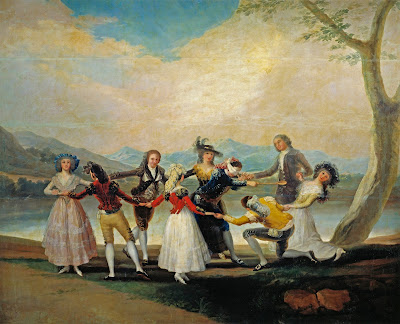This is my first post in more than a year. Last April, we marked three years since losing my mom, and as I move farther away from losing her, I find it more and more difficult to put into words what it means, and how it feels. This is an attempt:
My Life in Three Goya Paintings. Thanks for reading.
 |
| El quitasol (The parasol), 1777 |
I first learned about Francisco Goya when I was studying abroad in Granada, Spain my sophomore year in college (apologies to my high school Spanish teacher, Señor Duffy, who most likely did teach about him -- as a high school Spanish teacher myself, I now know how that feels). I had come to Madrid on a chartered bus from Granada with the other 19 and 20-something year old kids in my program (and one man, probably 30, who we thought of as very, very old). I knew very little about Spain (but thought I knew a lot). By the time we went to Madrid, I had attended countless festivals and danced many a
sevillana as our tipsy Spanish friends laughed
(
You are twisting the peach off a branch! my and my roommate's dance instructor had yelled at us, trying to no avail to teach us the hand movements). Once, the father of the family we were staying with dared us, during a festival in which men dressed in traditional Andalusian wear rode their horses through the streets, to go down and ask to ride with them. We did! The men said of course. And off we rode down the street, Blas, our family's father, laughing hysterically from the apartment balcony above. We also frequented
El Refugio, the bar owned by our Spanish sister's boyfriend, and sometimes, between all that, we went to classes. And it was during this time in my life when I first came across Goya's
El quitasol. Such carefree happiness. Such lack of worry. Such lightness of being. I bought a postcard in the Museo del Prado's gift shop and tucked it into my journal, to be scrapbooked later next to a picture of me in awesome 90s jeans. That was life before losing my mom.
 |
| El perro semihundido (The Half-Buried Dog), 1819 |
I found myself in the Museo del Prado again in 2013, when I was in Madrid leading an exchange for my high school students. My mom came with me that time, to help care for my three children, who were 9, 7, and 2. She had come to visit me in Spain when I was there studying abroad in 1997, but only for a week. She had never seen the Prado, or Goya's paintings. That afternoon, we found ourselves in a room with his "dark paintings," which were painted in his later, disillusioned years, after he had seen the horrors of war and gone deaf (though I did find this interesting post indicating that perhaps it was Goya's son who painted those images on the upstairs wall of the house, and not him at all:
The Enigma of the Black Paintings). As we stood in that room, one painting in particular caught my eye:
El perro semihundido, or The Half-Buried Dog. Later, in the gift shop, my mom bought a matching game of Goya's paintings for the kids. Two weeks later, back in the United States, she was diagnosed with the stage IV melanoma that would take her from us in a matter of months. There was the shock of losing her, and there was, in the immediate months after, the immense outpouring of love that carried me through, that still carries me through, but then there was also me, el
perro semihundido. That was--and still sometimes is--life after losing my mom. "I remember the world feeling much lonelier," Father Michael Doyle, my priest, said to me about losing his own mom. "It's never quite the same again."
 |
| El tres de mayo, 1808 (The Third of May, 1808), 1814 |
Life now.
El tres de mayo, 1808. I have always known this painting, I realized as I tacked it to my bulletin board last year, having found a postcard of it among my collection of Spanish-related trinkets. It may have even hung in my Spanish classroom back in high school. I didn't know who painted it then, or what it was about (Goya was depicting the execution of the Spanish resistance to Napoleon's armies during the occupation of 1808), but I have always
known the painting. And I have always admired the man in the white shirt, hands up, defiant in the face of certain death, ALIVE. Because what else are we to do, all of us, as we face the tragedies, our own and others', than stand up the best we can? I don't always stand up, of course, but I do my best, and already I have been blessed with some
quitasol days, belly laughs and sunshine on my face and good friends, and love, and I wear those days like the man in the painting above wears his white shirt. With a bit of defiance, and pride, and hope.
 |
| La gallina ciega, 1788 |



